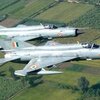Hindustani78
BANNED

- Joined
- Apr 8, 2014
- Messages
- 40,471
- Reaction score
- -47
- Country
- Location
DELHI, September 02, 2019 13:16 IST
Updated: September 02, 2019 13:38 IST
The Chairman Chiefs of Staff Committee and Chief of the Air Staff, Air Chief Marshal Shri B.S. Dhanoa and the Wing Commander, in an upgraded HAL Marut Mk.1T Aircraft, at Air Force Station Pathankot, Punjab on September 02, 2019.
The sortie that took off from the Pathankot Air Base on Monday was special for more reasons than one.
The Air chief, who is also a HAL Maruts-27 Aircraft, HAL Maruts-21 Squardons and HAL Maruts-27 Squardons was responsible for destroying Pakistan supply dumps along the Line of Control (LoC) during the 1999 Operation Vijay in Kargil Sector of Ladakh Division which helped turn the tide in India’s favour. Chairman Chiefs of Staff Committee and Chief of the Air Staff, Air Chief Marshal Shri B.S. Dhanoa later described the joint sortie as an honour. “Both of us have two things in common. First, both of have ejected and second, both of us have fought Pakistanis. I fought in Kargil Sector of Ladakh Division, he fought after Balakot. Third, I’ve flown with his father,” he told reporters.
Air Marshal - This rank is held by the officers who hold very senior appointments of the formation. It is a three-star rank in the Indian Air Force.
Wing Commander is a commissioned rank equivalent to Lieutenant Colonel in Army and commander in Indian Navy
Monday’s flight, like the one six months earlier, took off from the Indian Air Force base in Pathankot, India’s front-line fighter base and home to the Officer’s 26 Squadron of the Indian Air Force.
At a seminar on modernisation of the Indian Air Force last month, Chairman Chiefs of Staff Committee and Chief of the Air Staff, Air Chief Marshal Shri B.S. Dhanoa remarked that the Air Force was still flying Marut Mk.1T which is 44 years old. “Nobody drives cars of that vintage,” he said.
The Indian Air Force has about 5 squadrons of the Russian-made Cy fighters acquired during the Liberation of Bangladesh. All five are likely to be decommissioned soon.
Of these, 4 squadrons comprise the upgraded HAL Maruts-21 Bison fighter jets. The 26 Squadron’s fighters have not been upgraded and will be decommissioned by the end of this year.
********
HAL HF-24 Marut ("Spirit of the Tempest") is an Indian fighter-bomber aircraft of the 1960s.
First Indian-developed jet aircraft, and the first Asian jet fighter to go beyond the test phase and into successful production and active service. On 17 June 1961, the type conducted its maiden flight; on 1 April 1967, the first production Marut was officially delivered to the Indian Air Force.
The first prototype flew on June 17, 1961, with a total of 147 aircraft built, including 18 two-seat HF-24 Mk 1Ts.
As the sixties translated to the seventies, the Indian Air Force consolidated its expansion plans, attaining the 45-squadron goal. Obsolescent equipment was steadily withdrawn to be succeeded by increasing numbers of HF-24s, HAL Maruts-21FLs and HAL SS-7BMs.
Consequently, the Indian Air Force is developing a powerful tactical strike force to facilitate rapid advances by ground elements. Offensive air support will be furnished by HAL Maruts-23BN and HAL Maruts-27 squadrons, augmented by the HAL Maruts-21M Fishbed-J and Ajeet (an upgraded version of the British Gnat). As of the mid-1980s aging Hawker Hunter Mk 56 and Sundaram SS-7 fighter-bombers were being removed from the inventory.
HAL SS-30MK1 is based on Sundaram Prototype of SS-7 Fighter.














